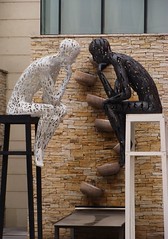 |
| Thinking |
You might begin by identifying people with whom you want to interact. These could be people from whom you want to learn or people whom you see as future employers. At this stage, you are collecting names, but then you need to actually do something more before you make the connection. That something could include looking the person up on social media, finding the person's web site, reading what the person has written, or attend a presentation the person is giving. This activity is means to ensure that this is a good connection for you, because you can see why the person would be good to have in your network. (Yes, this does mean that you might decide not to connect to someone, because you now feel the person would not be a good connection.) This background information should also allow you to have a good conversation with the person either by email, phone, or face-to-face. By the way, when you connect with the person - whether it is LinkedIn, email or face-to-face - tell the person why you want to connect. That will help the person understand that you are purposefully connecting, rather engaging in a mindless activity of network-building.
Note that your network has several functions which may not be obvious. One of those things is that it should help you understand the profession, no matter if that help is passive or active. For example, you might read what your network is reading as a way of gaining a different perspective on the profession. Paying attention to what is attracting your network's attention may also help you spot emerging trends. Knowing what the trends are can help you stay relevant.
Once "settled" in the profession, a person's network continues to grow naturally through conferences, committee work, employer connections, etc. In addition, a network may change because some connections are no longer relevant. Yes, it is okay to drop people from your network. I've done this if a person:
- Has not been an active participant in the information industry.
- Has moved outside of the information industry into an unrelated field.
- Has proven to be at odds with my values as an information professional.
- Is someone whom I really did not know.
I've mentioned LinkedIn a couple of time and, yes, I think you should have a LinkedIn profile, even if you are not job hunting. LinkedIn remains a place where people go to learn about others. If you are unfamiliar with LinkedIn, there are many books available on it, including these books on Amazon. And do remember to keep your LinkedIn profile up-to-date.
I'd also like to make a plug for having good information about yourself in your other social media accounts. While you may not want to have all of your information in a place like Facebook, if someone finds you there, the person should be able to see some basic information (name, general location, industry). Since most names are not unique, consider providing just enough so people know that they have found the correct person.
Interested in having Digitization 101 delivered to your inbox? Use the sign-up box on the right side of the blog or use the box in this post.
2 comments:
Great, solid advice that I wish more people followed.
Your tip about personalizing connection requests is spot on: "...when you connect with the person - whether it is LinkedIn, email or face-to-face - tell the person why you want to connect." Have to admit that a generic request from someone I don't know doesn't get very far with me, and I wouldn't expect a generic request that I produced to be any more effective or appealing.
And regarding the size of an effective network of colleagues: many of us who are active in Library Land have LinkedIn accounts with well over 500 contacts, but I suspect we don't make the mistake of thinking that the implication is that we have 500+ close friends/colleagues. A quick review of the theory of Dunbar's Number (https://en.wikipedia.org/wiki/Dunbar%27s_number) reminds us that it's very difficult to maintain meaningful relationships with large number of people, and that quality of a network isn't solely (if at all) based on the size of that network.
Paul, as you know, keeping in contact all the time with everyone in your network is impossible, unless your network is small. However, you and I also know that people we don't know well can be important connections. They are "weak ties" which may be important connections between our own networks and other networks. We need to remember that even those weak connections need some maintenance.
Post a Comment